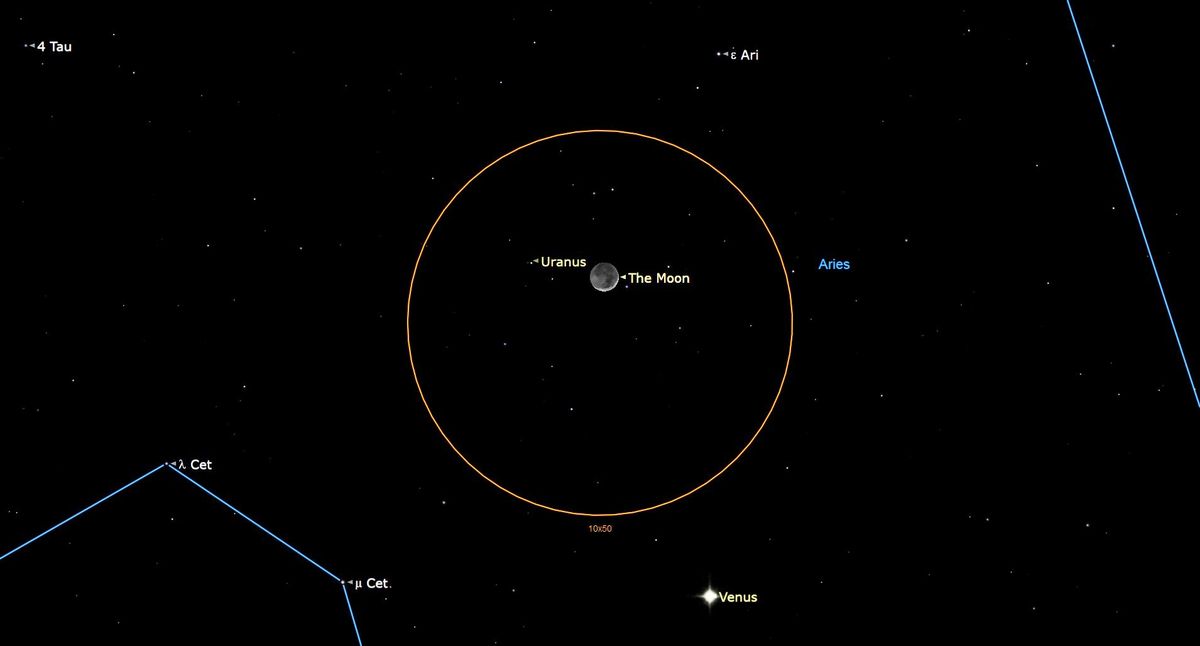
The moon will be close to Uranus in the sky tonight (March 24) offering skywatchers an excellent guide to spotting the ice giant.
Uranus, the seventh planet from the sun located towards the solar system's outskirts, will be just two lunar widths to the left of the moon during the evening on Friday for observers in eastern America. The moon will be in its waxing crescent phase as light creeps across its face signaling the transition from the fully dark new moon on Tuesday to the completely illuminated full moon on April 6, also known as the Full Pink Moon.
During this close encounter, the planet Uranus will have a magnitude of 5.8 and should be visible with binoculars or a small telescope appearing as a blue-green dot. Below the moon and Uranus will be the second planet from the sun, Venus.
Related: Night sky, March 2023: What you can see tonight [maps]
For skywatchers in more westerly time zones on the American continent, the moon will have moved eastwards over Earth and will thus have separated further from Uranus during the evening, appearing above the ice giant rather than to its right.
According to In the Sky (opens in new tab), from New York City on Friday the crescent moon will rise at 07:32 EDT (1132 GMT), reaching its highest point at 13:54 EDT (1754 GMT) and setting at 20:29 EDT (2329 GMT). Uranus will rise at 08:48 EDT (1248 GMT), reaching its highest point over the horizon at around 15:50 EDT (1950 GMT) and setting at 22:51 EDT (0251 GMT).
Though Uranus and the moon will make a close approach in the evening sky on Friday, this is just a matter of perspective from Earth and they will still remain widely separated in the solar system. The moon is just an average of 239,000 miles (384,400 kilometers) from Earth, but the closest Uranus ever comes to our planet is 1.6 billion miles (2.6 billion km) away. At their most widely separated there are 1.98 billion miles (3.2 billion km) between Earth and Uranus.
That isn't the only vast difference between Uranus and the moon, as the classification "ice giant" suggests the seventh planet from the sun dwarfs our planet and its moon. With a diameter of 31,000 miles (50,000 km), Uranus is about four times the size of Earth, which has a diameter of 7,900 miles (12,800 km). Earth itself is four times larger than the moon, which has a diameter of 2,100 miles (3,500 km), which means Uranus is almost 15 times the size of the moon.
The ice giant which is composed of an icy fluid of water, methane, and ammonia, over a solid rock core, also dwarfs Earth and the moon in terms of mass, possessing 14.5 times the mass of our planet.
If you're hoping to see Uranus during this close approach to the waxing crescent moon our guides to the best telescopes and best binoculars are a great place to start. If you're looking to snap photos of the night sky in general, check out our guide on how to photograph the moon, as well as our best cameras for astrophotography and best lenses for astrophotography.
Fancy taking a more in-depth moonlit tour of our rocky companion? Our ultimate guide to observing the moon will help you plan your next skywatching venture whether it be exploring the lunar seas, mountainous terrain, or the many craters that blanket the landscape. You can also see where astronauts, rovers and landers have ventured with our Apollo landing sites observing guide.
Editor's Note: If you snap the ice giant Uranus and would like to share it with Space.com's readers, send your photo(s), comments, and your name and location to spacephotos@space.com.
Follow us @Spacedotcom (opens in new tab), or on Facebook (opens in new tab) and Instagram (opens in new tab).
https://news.google.com/rss/articles/CBMiOWh0dHBzOi8vd3d3LnNwYWNlLmNvbS9zZWUtbW9vbi1wb2ludC10by11cmFudXMtbWFyY2gtMjAyM9IBAA?oc=5
2023-03-24 10:00:32Z
CBMiOWh0dHBzOi8vd3d3LnNwYWNlLmNvbS9zZWUtbW9vbi1wb2ludC10by11cmFudXMtbWFyY2gtMjAyM9IBAA
Bagikan Berita Ini














0 Response to "Want to see Uranus? The crescent moon points the way tonight (March 24) - Space.com"
Post a Comment